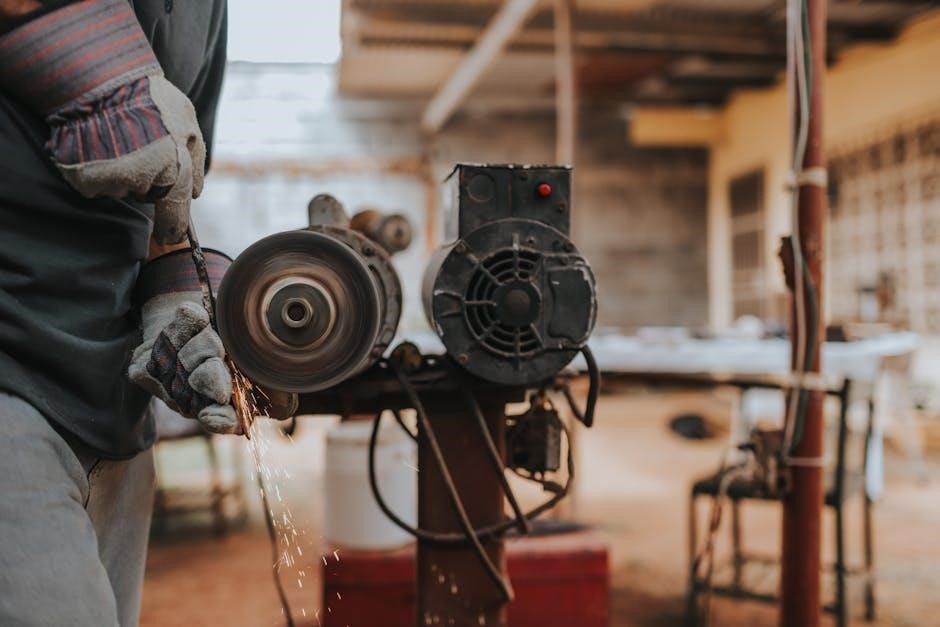Tooling PDFs are comprehensive resources for manufacturing professionals, detailing tool design, setup, and maintenance. They provide essential guidelines for optimizing performance and ensuring tool longevity in industrial applications.
What is Tooling PDF?
A Tooling PDF is a detailed document providing comprehensive insights into tool design, setup, and maintenance. It serves as a valuable resource for manufacturing professionals, offering guidelines for optimizing tool performance, longevity, and application across various industries. These documents often include technical specifications, material recommendations, and best practices for tooling in sectors like aerospace, automotive, and energy. Tooling PDFs are essential for ensuring precision, durability, and efficiency in modern manufacturing processes, making them indispensable for both novice and experienced practitioners.
Importance of Tooling PDF in Manufacturing
Tooling PDFs are vital for standardizing manufacturing processes, enhancing efficiency, and reducing errors. They provide detailed guidelines for tool setup, maintenance, and optimization, ensuring consistency across production lines. These resources are critical for improving tool longevity, reducing downtime, and boosting overall productivity. By offering industry-specific solutions and best practices, Tooling PDFs empower manufacturers to adapt to evolving demands and maintain high standards of quality. Their comprehensive insights make them indispensable for achieving operational excellence in modern manufacturing environments.
Tooling Manuals and Guides
Tooling manuals and guides offer detailed instructions for setting up, programming, and maintaining tools, ensuring optimal performance and adherence to industry standards in manufacturing processes.
Overview of Tooling Manuals
Tooling manuals provide detailed instructions for setting up, programming, and maintaining tools, ensuring optimal performance. They cover troubleshooting, safety protocols, and best practices for specific applications. These guides are essential for manufacturers to maximize tool longevity and efficiency. From injection molding to CNC machining, tooling manuals offer tailored solutions. They often include step-by-step programming instructions, such as those found in the Doosan Live Tooling Turning Programming Manual, and industry-specific insights, like the Gartner Market Guide for Cloud Management Tooling. These resources are critical for achieving precision and consistency in manufacturing processes.
Doosan Live Tooling Turning Programming Manual
The Doosan Live Tooling Turning Programming Manual is a detailed guide for setup, programming, and maintenance of live tooling systems. It provides step-by-step instructions for optimizing CNC machining processes. The manual emphasizes securing the base plate and workpiece, ensuring precise tool alignment. Designed for advanced manufacturing, it covers tool selection, operation, and troubleshooting. This resource is invaluable for professionals seeking to enhance productivity and accuracy in their machining operations, ensuring tools operate at peak performance and longevity.
Gartner Market Guide for Cloud Management Tooling
The Gartner Market Guide for Cloud Management Tooling provides insights into cloud management platforms, offering evaluations of leading vendors and tools. Published in 2021 by Dennis Smith, Padraig Byrne, and Josh Chessman, it highlights trends, challenges, and best practices for selecting cloud management solutions. This guide is essential for IT leaders and professionals seeking to optimize cloud infrastructure, ensuring scalability, security, and efficiency in their operations. It serves as a valuable resource for aligning cloud strategies with business goals.

Tooling Applications
Tooling applications cover various manufacturing processes, including injection molding, CNC machining, and railway wheel machining, ensuring precision and efficiency in producing high-quality components for diverse industries.
Tooling for Injection Molding
Tooling for injection molding is critical for producing high-quality plastic components. It involves designing and maintaining molds to ensure precision and durability. Proper mold care and maintenance are essential for optimizing efficiency and preventing defects. Materials like high-quality carbon steel with a black oxide finish are often used for their corrosion resistance and longevity. Advanced tooling solutions, such as energy-saving mechanisms, can reduce wear and tear, enhancing overall performance. Regular updates and guides provide practical tips for improving injection molding processes and tooling durability.
Tooling for CNC Machining
Tooling for CNC machining involves precision cutting tools designed for high-speed operations. A lathe tooling guide provides insights into selecting the right inserts and tools for specific tasks. Proper setup and alignment are crucial, with step-by-step instructions for securing the base plate and workpiece. High-quality carbon steel with a black oxide finish enhances tool durability and corrosion resistance. Advanced features like energy-saving ratcheting mechanisms improve efficiency. Regular maintenance and updates ensure optimal performance, maximizing tool longevity and precision in CNC applications.
Tooling for Railway Wheel Machining
Tooling for railway wheel machining involves specialized cutting tools designed for precision and durability. These tools are essential for maintaining and manufacturing railway wheels, ensuring safety and efficiency. High-quality carbon steel with a black oxide finish is often used for corrosion resistance. Advanced tooling solutions optimize machining processes, reducing wear and tear. Proper setup and maintenance are critical to achieve accurate results. These tools play a vital role in the railway industry, supporting both new wheel production and routine maintenance operations.
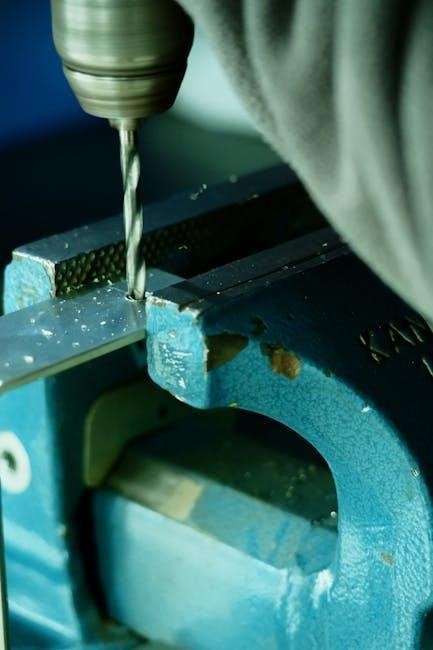
Tooling Materials and Maintenance
High-quality materials like carbon steel with black oxide finishes enhance durability and corrosion resistance. Regular maintenance ensures optimal tool performance and extends lifespan in industrial applications.
High-Quality Carbon Steel for Tooling
High-quality carbon steel is a preferred material for tooling due to its strength and durability. Tools made from carbon steel, often finished with a black oxide coating, offer excellent corrosion resistance and longevity. This material is ideal for demanding applications, including injection molding and CNC machining. Proper maintenance, such as regular lubrication and storage in dry conditions, ensures optimal performance. The use of high-quality carbon steel in tooling enhances overall efficiency and reduces the need for frequent replacements, making it a cost-effective solution for industrial operations.
Black Oxide Finish for Corrosion Resistance
A black oxide finish is a chemical conversion coating applied to metal tools to enhance corrosion resistance and durability. It is commonly used on high-quality carbon steel tooling, providing a protective layer that withstands harsh environments. This finish is particularly beneficial in industrial applications where moisture and wear are prevalent. The black oxide coating not only extends tool life but also reduces maintenance needs, ensuring optimal performance in manufacturing processes such as injection molding and CNC machining. Its effectiveness makes it a preferred choice for tooling requiring long-term reliability.
Best Practices for Tool Maintenance
Regular tool maintenance is crucial for ensuring optimal performance and longevity. Always follow manufacturer guidelines, perform routine inspections, and clean tools thoroughly after use. Proper storage in dry environments prevents corrosion. Lubricate moving parts to reduce wear and tear. Implement a systematic maintenance schedule to identify and address issues early. These practices minimize downtime, enhance precision, and extend tool life, ultimately improving overall manufacturing efficiency and productivity. Consistent care ensures tools remain reliable and effective for their intended applications.
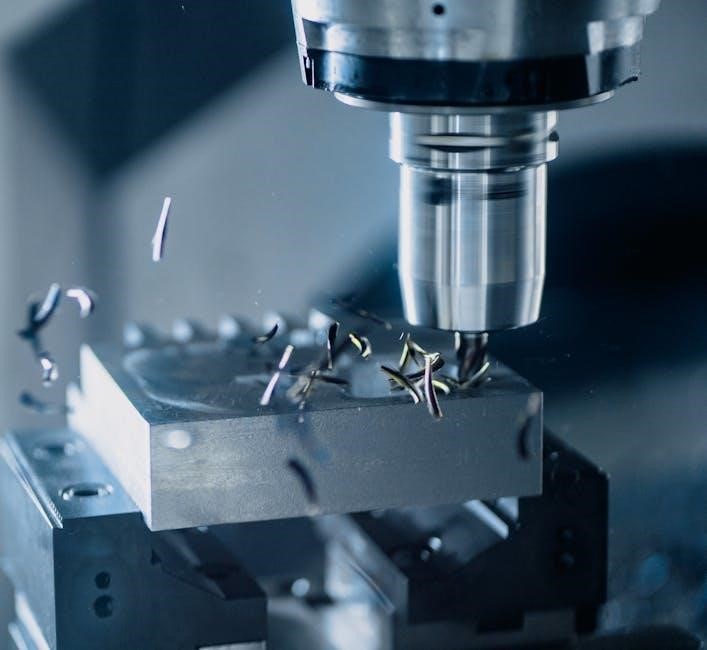
Tooling for Specific Industries
- Aerospace: Precision tooling for high-performance materials and complex geometries.
- Automotive: Durable tools for high-volume manufacturing and consistent quality.
- Energy: Robust solutions for harsh environments and heavy-duty applications.
Tooling for Aerospace
Aerospace tooling requires high precision and durability to handle advanced materials and complex geometries. Tools are designed for lightweight yet strong components, ensuring resistance to extreme conditions. Custom solutions are often needed for specific aircraft parts, leveraging materials like carbon steel with black oxide finishes for corrosion resistance. These tools are critical for maintaining performance and longevity in demanding aerospace environments, where reliability is paramount for safety and operational efficiency.
Tooling for Automotive
Automotive tooling involves specialized equipment for manufacturing and maintaining vehicle components. High-quality carbon steel tools with black oxide finishes ensure durability and corrosion resistance. These tools enhance precision and efficiency in producing engine parts, body panels, and other critical components. Energy-saving mechanisms and advanced designs optimize automotive production processes. Proper maintenance and selection of tools are essential for ensuring vehicle safety, performance, and longevity in the competitive automotive industry.
Tooling for Energy and Utilities
Tooling for energy and utilities is designed to enhance efficiency and safety in power generation, distribution, and renewable energy systems. High-quality carbon steel tools with black oxide finishes provide durability and corrosion resistance, ideal for harsh environments. Energy-saving mechanisms reduce operational costs, while durable tooling solutions ensure long-term performance. These tools support critical applications, from electrical cable cutting to renewable energy installations, ensuring reliability and precision in the energy sector. Regular maintenance and advanced tooling solutions are vital for sustained efficiency and safety.
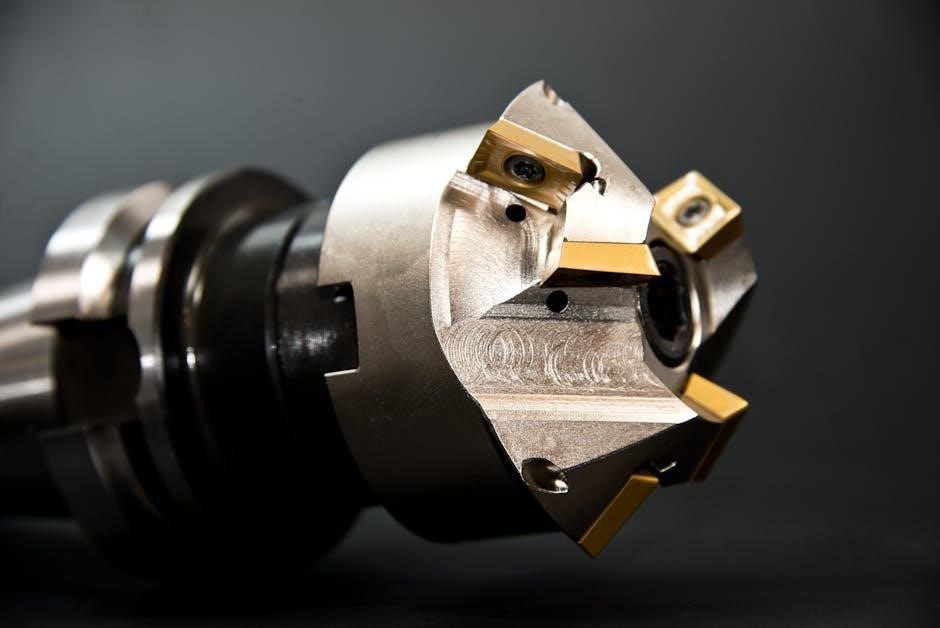
Programming and Setup Guides
Programming and setup guides provide step-by-step instructions for tooling configuration. They cover securing base plates, workpiece alignment, and energy-saving mechanisms, ensuring efficient and precise tool operation.
Setting Up Your Cat Hose Products
Setting up your Cat Hose Products requires careful attention to ensure optimal performance. Begin by reviewing the step-by-step instructions in the user manual. Properly secure the base plate to the workpiece, ensuring alignment with the template guide. Tighten all screws firmly to avoid any movement during operation. Regular maintenance, such as cleaning and lubricating moving parts, is essential for longevity. Refer to the troubleshooting section for common issues and solutions. Follow these guidelines to maximize efficiency and ensure smooth operation of your Cat Hose Products.
Step-by-Step Programming Instructions
Step-by-step programming instructions are essential for ensuring accurate and efficient tooling operations. Begin by reviewing the user manual for specific setup requirements. Initialize the system by entering the recommended parameters. Carefully input the program code, verifying each step for accuracy. Conduct a test run to ensure proper functionality. Adjust settings as needed and secure the base plate firmly to prevent movement. Regularly update software and refer to troubleshooting guides for resolving common issues. Follow these instructions to achieve precise and reliable results in your tooling applications.
Securing the Base Plate and Workpiece
Securing the base plate and workpiece is critical for precise tooling operations. Begin by fitting the tool onto the base plate and tightening it firmly with screws. Ensure the workpiece is properly aligned and clamped to prevent movement during machining. Use a template guide to slide along the side of the workpiece for accurate positioning. Double-check all connections and alignment before initiating operations. Proper securing ensures stability, reduces vibration, and enhances overall machining accuracy, leading to high-quality results and extended tool longevity.
Tooling Catalogs
Tooling catalogs provide detailed listings of tools for various industries. They include specialized tools for space, rail, and industrial applications, ensuring precision and durability in manufacturing processes.
Tools for Space
Tools for space applications are designed for high-performance and precision in extreme environments. Made from materials like titanium and advanced alloys, they ensure durability and resistance to harsh conditions. These tools are used in spacecraft and satellite manufacturing, offering specialized solutions for unique challenges. Customizable options cater to specific mission requirements, ensuring reliability and efficiency. Durable tooling solutions are essential for space exploration, providing long-term performance in critical operations. These tools are engineered to meet the highest industry standards, supporting advancements in space technology and exploration.
Tools for Rail
Tools for rail applications are designed to meet the demands of railway maintenance and manufacturing. They include specialized equipment for railway track cutting, wheel machining, and cable handling. Durable materials like high-quality carbon steel with black oxide finishes ensure longevity and corrosion resistance. These tools are essential for maintaining railway infrastructure, enabling efficient and safe operations. Energy-saving mechanisms are integrated to enhance performance, while precision engineering ensures accuracy in cutting and machining tasks. Rail-specific tooling solutions are vital for modern railway systems, supporting reliability and operational excellence.
Sauer Machine Company Catalog
The Sauer Machine Company Catalog offers a detailed overview of high-quality tooling solutions tailored for the corrugated industry. Renowned for their precision and durability, Sauer’s tools are designed to meet the specific needs of modern manufacturing. Their Sauer System product line is a standout, featuring innovative designs that enhance operational efficiency. The catalog provides comprehensive insights into their tooling range, ensuring customers can make informed decisions. It serves as a trusted resource for professionals seeking reliable and advanced tooling options.
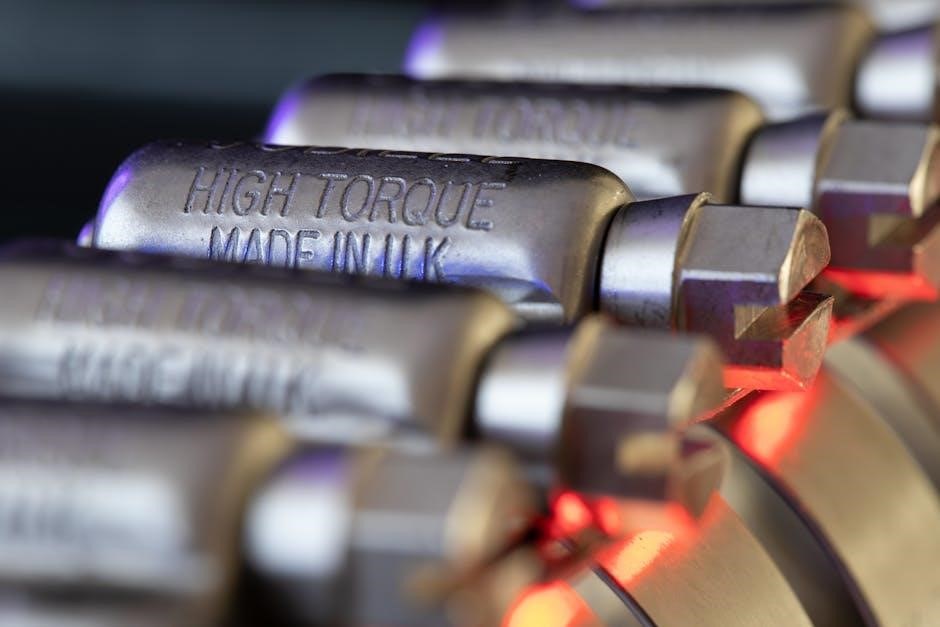
Tooling Examples and Case Studies
Explore real-world applications of tooling in railway track cutting, electric cable machining, and high-performance punch tools. These case studies highlight efficiency, precision, and durability in industrial operations.
Railway Track Cutting Tools
Railway track cutting tools are essential for maintaining and repairing rail infrastructure. Designed for precision, these tools ensure efficient cutting, trimming, and finishing of railway tracks. Made from high-quality materials like carbon steel with a black oxide finish, they offer durability and corrosion resistance. Their robust construction allows for heavy-duty applications, ensuring smooth operations in challenging environments. These tools are vital for extending the lifespan of railway components, reducing maintenance downtime, and enhancing overall rail network efficiency. Their reliability makes them indispensable in modern railway maintenance workflows.
Electric Cable Cutting Tools
Electric cable cutting tools are designed for precise and efficient cable trimming and termination. These tools are crucial in electrical systems, ensuring clean cuts that prevent damage to conductors. Made from high-quality materials like carbon steel with a black oxide finish, they offer durability and corrosion resistance. Their ergonomic design and energy-saving ratcheting mechanisms reduce user fatigue. Ideal for industrial and utility applications, these tools facilitate smooth electrical connections, making them essential for maintaining reliable power distribution systems and ensuring operational efficiency in various industries.
High-Quality Punch and Anvil Tools
High-quality punch and anvil tools are essential for precise metal fabrication and electrical systems. Crafted from durable carbon steel with a black oxide finish, they ensure corrosion resistance and longevity. Standard punch lengths are 4 inches (101.6mm), while anvils measure 3 inches (76.2mm), with a 5/8 inch (15.9mm) diameter. Designed to fit 3/8 inch holes, these tools deliver consistent performance. Ideal for applications like crimping, punching, and shaping, they provide reliability and accuracy in various industrial and utility settings, ensuring efficient and professional results.

Tooling Standards and Specifications
Tooling standards ensure consistency and quality in manufacturing. Standard punch lengths are 4 inches, anvils 3 inches, with a 5/8 inch diameter. Authorized suppliers meet strict specifications.
Standard Length for Punches and Anvils
Standard lengths for punches and anvils are critical for consistency in tooling applications. Punches typically measure 4 inches (101.6 mm), while anvils are 3 inches (76.2 mm) in length. Most punches and anvils feature a 5/8 inch (15.9 mm) diameter, ensuring compatibility across various tooling systems. These dimensions are designed to maximize performance and interchangeability, adhering to industry standards for precision and reliability in manufacturing processes. Proper sizing ensures optimal functionality and alignment in tooling operations.
Diameter and Fit for Punches
The standard diameter for punches is typically 5/8 inch (15.9 mm), ensuring compatibility with most tooling systems; Proper fit is crucial, as it prevents radial play and ensures precise alignment. The diameter must match the anvil’s opening to maintain optimal performance and prevent damage. Standardization in diameter and fit ensures interchangeability and simplifies tool setup. High-quality materials, like carbon steel with a black oxide finish, enhance durability and corrosion resistance, making punches reliable for demanding applications. Proper fitting also reduces wear and extends tool life.
Authorized Suppliers for US Defense
Authorized suppliers for US defense must meet stringent standards, ensuring tools are reliable and durable. DMC, for instance, is recognized as an authorized supplier, providing tools for critical systems like the B-58 bomber. These suppliers adhere to strict quality control and material specifications, such as high-quality carbon steel with black oxide finishes, to ensure corrosion resistance and longevity. Their tools are designed for precision and durability, meeting the demanding requirements of defense applications while maintaining versatility for other industries.

Tooling for Corrosion Resistance
High-quality carbon steel with black oxide finish enhances corrosion resistance and durability. Energy-saving mechanisms reduce effort, ensuring prolonged tool longevity in harsh environments.
Black Oxide Finish Benefits
The black oxide finish offers exceptional corrosion resistance, making it ideal for tools exposed to harsh environments. It enhances durability and prolongs tool longevity. The finish reduces friction, improving mechanical efficiency and energy savings. Aesthetically, it provides a uniform, professional appearance. This cost-effective treatment is widely used in manufacturing, ensuring tools remain reliable and perform optimally over time. Its benefits make it a popular choice for industries requiring high-quality, long-lasting tooling solutions.
Energy Saving Ratcheting Mechanism
The energy-saving ratcheting mechanism reduces manual effort and increases operational efficiency. It minimizes energy consumption while maintaining precision and control. This mechanism is designed for durability, ensuring long-term performance. By integrating advanced engineering, it optimizes tool functionality and reduces wear. Ideal for industrial applications, it enhances productivity and reliability. The energy-saving feature makes it eco-friendly, aligning with modern sustainability goals. This innovative solution is widely adopted in various industries, including aerospace and automotive, for its effectiveness and efficiency.
Durable Tooling Solutions
Durable tooling solutions are engineered to withstand rigorous manufacturing environments, ensuring longevity and reliability. High-quality materials, such as carbon steel with a black oxide finish, provide exceptional corrosion resistance. These tools are designed for minimal wear and tear, reducing downtime and extending tool life. Advanced coatings and precision engineering enhance durability, making them ideal for demanding applications. Whether for aerospace, automotive, or energy industries, durable tooling solutions deliver consistent performance, ensuring efficient and high-quality production processes. Their robust construction minimizes maintenance needs, optimizing overall manufacturing efficiency.
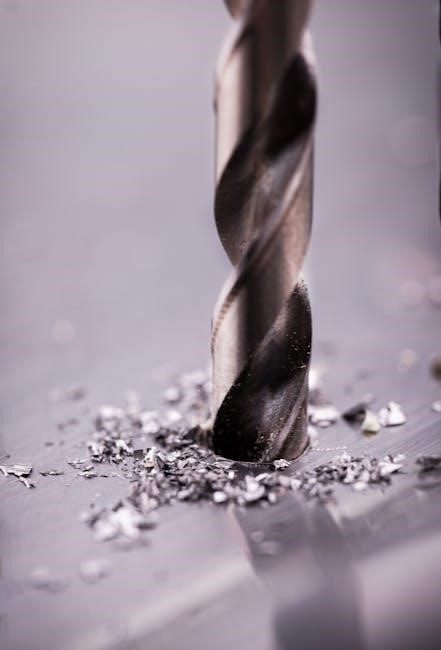
Tooling Guides for Specific Applications
Tooling guides for specific applications provide tailored instructions and best practices for various manufacturing processes, ensuring efficiency and precision in industrial operations.
Crimp Tool for Electrical Systems
The MS3191-1 crimp tool is designed for maintaining electrical systems on the B-58 bomber. It ensures secure connections for wires and contacts, supporting aerospace applications.
This tool is specifically engineered for precision and durability, making it essential for high-reliability electrical systems. It is widely used in aerospace and defense industries.
DMC became an authorized supplier of tools for the US, highlighting its trusted performance in critical applications.
Lathe Tooling Guide
A comprehensive reference for understanding cutting tools and their applications, the Lathe Tooling Guide provides insights into tool selection and optimization. It details how to pair tools with specific inserts for precise machining operations.
Designed for both professionals and hobbyists, the guide offers practical advice on tool setup, maintenance, and troubleshooting. It ensures optimal performance in various lathe machining tasks.
By following the guide, users can enhance machining accuracy, reduce downtime, and improve overall productivity in their workshops or manufacturing environments.
Quick Location Chart for Contacts
The Quick Location Chart for Contacts provides a detailed mapping of connector contacts, including color codes and configurations. It helps users identify shielded and power contacts efficiently.
This chart is essential for electrical system design and troubleshooting, ensuring accurate connections and minimizing errors. By referencing this guide, professionals can streamline their work and maintain system integrity.
Updated regularly, the chart reflects the latest standards, making it a reliable resource for manufacturers and engineers working with complex electrical systems and tooling applications.

Future Trends in Tooling
Future trends in tooling emphasize advanced precision cutting tools, energy-saving mechanisms, and smart manufacturing technologies to enhance efficiency and productivity in industrial applications.
State-of-the-Art Precision Cutting Tools
State-of-the-art precision cutting tools are revolutionizing manufacturing by offering advanced materials and designs. High-quality carbon steel with black oxide finishes ensures durability and corrosion resistance. These tools, like the MS3191-1 crimp tool, are engineered for specific applications, enhancing efficiency and accuracy. Modern advancements focus on energy-saving mechanisms and extended tool longevity, making them indispensable for industries like aerospace and automotive. Such tools are detailed in resources like the Doosan Live Tooling Turning Programming Manual, providing comprehensive guides for optimal performance and maintenance.
Maximizing Tool Longevity and Performance
Maximizing tool longevity and performance involves proper maintenance and material selection. High-quality carbon steel with a black oxide finish ensures corrosion resistance and durability. Regular tool inspections and adherence to best practices, such as securing the base plate and workpiece, prevent wear and tear. Energy-saving ratcheting mechanisms reduce operational strain, while step-by-step programming guides enhance precision. These strategies, detailed in resources like the Doosan Live Tooling Turning Programming Manual, help extend tool life and optimize manufacturing efficiency.
Advanced Tooling for Modern Manufacturing
Advanced tooling integrates state-of-the-art technologies to enhance manufacturing efficiency. Precision cutting tools, energy-saving mechanisms, and durable materials like high-quality carbon steel with black oxide finishes are key innovations. These tools are designed to optimize performance in CNC machining, injection molding, and railway wheel applications. Modern tooling also emphasizes corrosion resistance and longevity, ensuring reduced downtime and higher productivity. Guides like the Gartner Market Guide for Cloud Management Tooling highlight these advancements, offering insights for industries to adopt cutting-edge solutions.
Tooling PDFs provide comprehensive insights into modern manufacturing, offering practical applications for efficiency and productivity. They highlight the importance of advanced tooling in achieving operational excellence and future success.
Tooling PDFs are essential resources for manufacturing, offering detailed insights into tool design, maintenance, and application. They cover materials like carbon steel and black oxide finishes, ensuring durability and corrosion resistance. Guides for injection molding, CNC machining, and railway wheel machining highlight specific industry needs. Manuals such as Doosan Live Tooling and Gartner’s Cloud Management Tooling provide step-by-step instructions and market trends. Best practices for tool maintenance and advanced technologies emphasize efficiency and longevity, making these PDFs invaluable for modern manufacturing professionals aiming to optimize performance and adapt to future trends.
Final Thoughts on Tooling PDF
Tooling PDFs are indispensable resources for manufacturing professionals, offering insights into tool design, application, and maintenance. They provide practical guidance for optimizing performance and adapting to future trends. By covering materials, industry-specific solutions, and advanced technologies, these documents empower professionals to enhance efficiency and innovation. As manufacturing evolves, Tooling PDFs remain vital for staying competitive and achieving operational excellence in various industrial sectors.
